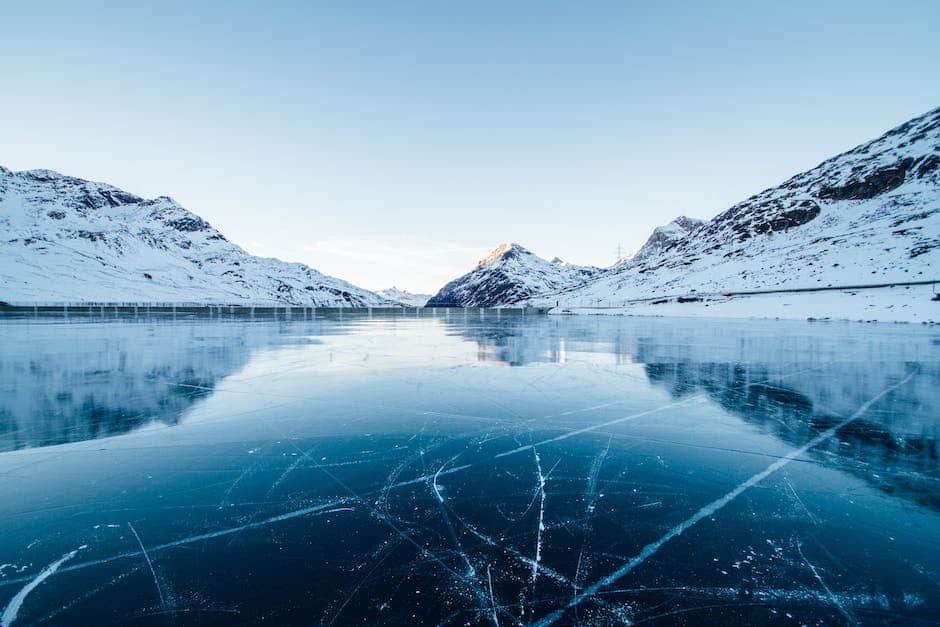As fall sets in and the weather gets colder, now is the perfect time to start preparing your winter vegetable garden. Kale is a hardy, leafy green that thrives in cold weather and can even be harvested after a light frost. If you have a bumper crop of kale or simply want to stock up for the winter, freezing is a great option. Read on for astep-by-step guide on how to freeze kale.
1. Rinse the kale in cold water and remove any unwanted debris.
2. Pat the kale dry with a clean towel or paper towel.
3. Cut the kale into pieces that are about 1-2 inches in size.
4. Place the kale pieces on a baking sheet lined with parchment paper.
5. Place the baking sheet in the freezer and allow the kale to freeze for 1-2 hours.
6. Once the kale is frozen, transfer it to a freezer safe bag or container.
7. Label the bag or container with the date and kale.
8. Store in the freezer for up to 6 months.
Can you freeze fresh kale without blanching?
Kale can be frozen without blanching, but it should be used within 4 weeks. Blanching greens before freezing stops the naturally-occurring ripening enzymes in the leaves, which will ensure that the leaves taste fresh and will not develop a bitter taste. Blanched kale will last up to 1 year in the freezer.
This is a great way to freeze kale so that you can use it for smoothies or as a side dish. Quick-freeze small clumps of kale individually on a cookie sheet, then place them in freezer bags in bulk. Remove as much air as possible from the bags before sealing.
Is it better to freeze kale raw or cooked
To blanch kale, bring a large pot of water to a boil and fill a large bowl with ice water. Add the kale to the boiling water and let it cook for 3 minutes. Remove the kale from the water with a slotted spoon and transfer it to the bowl of ice water. Let the kale cool for a few minutes, then drain it and transfer it to a freezer-safe container.
If you’re storing fresh kale, it’s best to reduce excess moisture by waiting to rinse the leaves until you’re ready to eat them. You can store fresh kale that hasn’t been cut by wrapping the leaves in a paper towel, placing them in a plastic bag like Glad® FLEX’N SEAL™ Gallon Bags and squeezing out any extra air before sealing. This will help keep the kale fresh and reduce the risk of spoilage.
Can you put kale straight in the freezer?
Kale and spinach are two of the most versatile and healthy leafy greens out there. But if you’re not used to cooking with them, they can seem a bit daunting. The good news is that you can easily freeze both kale and spinach, so you can have them on hand without them going bad in the back of your fridge.
Here’s how to freeze kale and spinach:
1. Wash the leaves thoroughly and dry them completely.
2. Remove any tough stems or ribs from the leaves.
3. Chop the leaves into bite-sized pieces, if desired.
4. Spread the leaves out on a baking sheet and place them in the freezer.
5. Once the leaves are frozen, transfer them to a freezer-safe container or bag.
6. Label the container with the date and contents, and return it to the freezer.
When you’re ready to use your frozen kale or spinach, there’s no need to thaw it first. Just add the frozen leaves directly to whatever dish you’re cooking. They’ll thaw quickly and be just as fresh and nutritious as if you’d used them fresh.
We highly recommend freezing kale to preserve it! Freezing locks in the nutrients, and, unlike other greens like spinach, kale is sturdy enough to retain a lot of its texture during the freezing process. This makes it a great option for smoothies, sautés, and other dishes where you want the kale to hold its shape.
What can I do with too much fresh kale?
1. Kale smoothie: in some ways, kale might seem like the last green that you’d want to add to a smoothie because its texture isn’t exactly, um, smooth, and its flavor can be a little bitter. But if you blend it with the right ingredients, kale can make a delicious and nutrient-packed smoothie. Try blending it with fruits like berries, bananas, and apples, or with other greens like spinach or Swiss chard.
2. Kale frittata: this is a great way to use up leftover kale. Simply sauté the kale with some onions and garlic, then add it to your usual frittata recipe.
3. Kale lettuce wraps: if you have some kale that’s starting to wilt, use it in place of lettuce in your wraps. The kale will add a nice crunch, and its flavor will be muted by the other ingredients in the wrap.
4. Summer kale and green goddess soup: this soup is perfect for summer, when kale is in season. Simply sauté the kale with some onions and garlic, then add it to your favorite green goddess soup recipe.
5. Kale chips: kale chips are a great way to get
Kale is a leafy vegetable that can be frozen and stored for up to 8 months. To freeze, simply transfer the kale leaves to a freezer bag.
What happens if you do not blanch a vegetable before freezing it
Blanching is a very important step in the process of freezing vegetables. It helps to slow or stop the enzyme action which can cause loss of flavor, color and texture. The blanching time is very important and varies with the vegetable and size.
Kale is a healthy leafy green vegetable that is full of nutrients. One way to cook kale is to blanch it. Blanching kale helps to retain its nutrients and color. To blanch kale, add the kale to boiling water and let it cook for 1-2 minutes. Then, remove the kale from the boiling water and transfer it to an ice bath to stop the cooking process.
Does frozen kale taste good?
If you don’t like the texture of fresh kale, you may want to try frozen kale instead. Frozen kale is more palatable after cooking.
Studies have shown that frozen veggies can actually be more nutrient-dense than their fresh counterparts. This is because they are typically frozen right after they’re harvested, which helps to preserve their nutrients. So if you’re looking to get the most out of your veggies, reach for the frozen versions!
How do you store kale so it doesn’t wilt
Kale is a leafy green vegetable that is packed with nutrients. It is low in calories and high in fiber, vitamins C, A, and K.
Washing kale is important to remove any dirt or debris that may be on the leaves. Be sure to remove all the excess moisture by patting the leaves dry with a clean towel.
Portioning out the kale will help it last longer in the fridge. Wrapping it loosely in clean paper towels will also help keep it fresh. Store the kale in a ziplock bag or airtight container in the crisper drawer of your fridge. It should last up to 6 days.
Washing, portioning, and wrapping kale is a great way to keep it fresh. Dry the leaves using a salad spinner for best results. Then, lay the kale leaves on a layer of clean paper towels, about 2-3 at a time. Store in the fridge in a labeled plastic bag.
How do you eat frozen kale?
Kale is a versatile vegetable that can be used in a variety of dishes, including soups, stews, smoothies, and salads. While it may not be ideal for kale chips or kale salad, frozen kale is a great way to add color and nutrition to your favorite recipes.
Kale is a great vegetable to freeze for later use. However, once frozen, the kale will never have the same crisp texture that it had before freezing. The water inside the kale will freeze, crystalize, and well, cause the thawed kale to be slightly less crisp. In other words, you won’t want to use thawed kale for a raw kale salad, because it’ll be too mushy. Use frozen kale instead for cooked dishes where a little extra texture won’t matter.
Why should you not eat too much kale
If you’re eating a lot of kale, you may experience some GI problems like bloating, diarrhea, gas, constipation, or even improper absorption of nutrients. Of course, you’d have to be eating a lot of kale to suffer these effects, but it’s still something to keep in mind.
Kale is a nutrient-dense food that’s high in several vitamins, minerals, and antioxidants. While cooking kale makes it less bitter, it also significantly reduces its antioxidant, vitamin C, and mineral content.
What happens if you don’t wash kale
It is important to wash your fruits and vegetables under running water to prevent consuming contaminated produce. Listeria, E coli, and Salmonella can be present on produce and can cause foodborne illnesses. In recent years, there have been several outbreaks of foodborne illnesses linked to contaminated produce. Washing your fruits and vegetables under running water can help prevent you from consuming contaminated produce and becoming ill.
Kale that has turned yellow in the fridge is still safe to eat, but may not taste as good because it is starting to get bitter. If you’re not a fan of bitter flavors, you may want to avoid eating kale that has been in the fridge for a while.
Can you eat kale stems
Cutting the stems crossways shortens the fibres, making them perfectly edible and preventing waste. Cut this way, the stems can be cooked in the same way as the rest of the leaf: sauteed, boiled or steamed. This is a great way to use up all of the leaf, and avoid wasting any part of it.
This is a great way to stop the cooking process if your vegetables are getting overcooked. Simply submerge them in ice-cold water and let them sit for a few minutes. This will halt the cooking process and give you a chance to adjust the heat on your stove. Just be sure to keep the vegetables in the ice water long enough for them to cool completely, then drain them well before serving.
What vegetables can you not freeze
There are a few fruits and vegetables that you should never freeze if you want to maintain their quality. These include celery, citrus fruits, cucumbers, green peppers, lettuce, parsleys, potatoes, and radishes. Frozen fruits and vegetables will often become limp and soft, with an unpleasant flavor. So if you want to enjoy these foods at their best, it’s best to avoid freezing them.
You will need to line a large baking sheet with parchment paper and spread out the greens along the surface. Try to keep them in a singular, flat layer. Place this baking sheet in the freezer and leave for 2 – 3 hours to freeze solid. Once this time has elapsed, remove the baking sheet from the freezer.
Do you wash kale before blanching
Kale is a nutrient-rich leafy green vegetable that can be enjoyed cooked or raw. To prepare kale for cooking, stem the leaves and wash them in 2 changes of water. Bring a large pot of water to a rolling boil, add salt to taste and the kale. Blanch for 3 minutes, then transfer to a bowl of cold water to stop the cooking, and drain. Kale can be enjoyed cooked in a variety of dishes, orraw in salads or as a healthy snack.
There are a few things to keep in mind when freezing vegetables:
-Except for onions and peppers, all vegetables should be blanched or cooked before being frozen. This stops enzymes that cause discoloration and turns frozen produce mushy.
-Raw fruit freezes just fine, so there’s no need to cook it before freezing.
-Be sure to package vegetables properly before freezing, using airtight containers or bags.
By following these simple tips, you’ll be able to enjoy fresh, frozen vegetables all year long!
Why kale should not be eaten raw
Consuming raw kale can be hard on the digestive system and can cause bloating, gas and other abdominal issues. It also contains a compound that can suppress thyroid function in certain people. If you are experiencing any of these issues, it is best to consult with a doctor or nutritionist to find out if raw kale is right for you.
Kale is a dark, leafy green you can eat raw or cooked. This superfood has been on dinner plates since Roman times and has long been common across much of Europe. The vegetable hails from the cabbage family, which also includes broccoli, cauliflower, and collards.
Kale is an excellent source of vitamins A, C, and K, and a good source of magnesium, iron, and calcium. It’s also low in calories and high in fiber.
Conclusion
You can freeze kale by washing it and removing the leaves from the stem. Then, blanch the kale in boiling water for two minutes before cooling it in an ice bath. Once it is cool, dry the kale and place it in a freezer bag.
There are a few different ways that you can freeze kale. You can either blanch it first, or you can just put it in a freezer bag. If you blanch it, you will need to shock it in ice water afterwards to stop the cooking process. If you don’t blanch it, you will need to massage it with a little bit of olive oil before freezing to prevent it from drying out. Whichever method you choose, make sure to label your bags with the date so you know how long it has been in the freezer.
